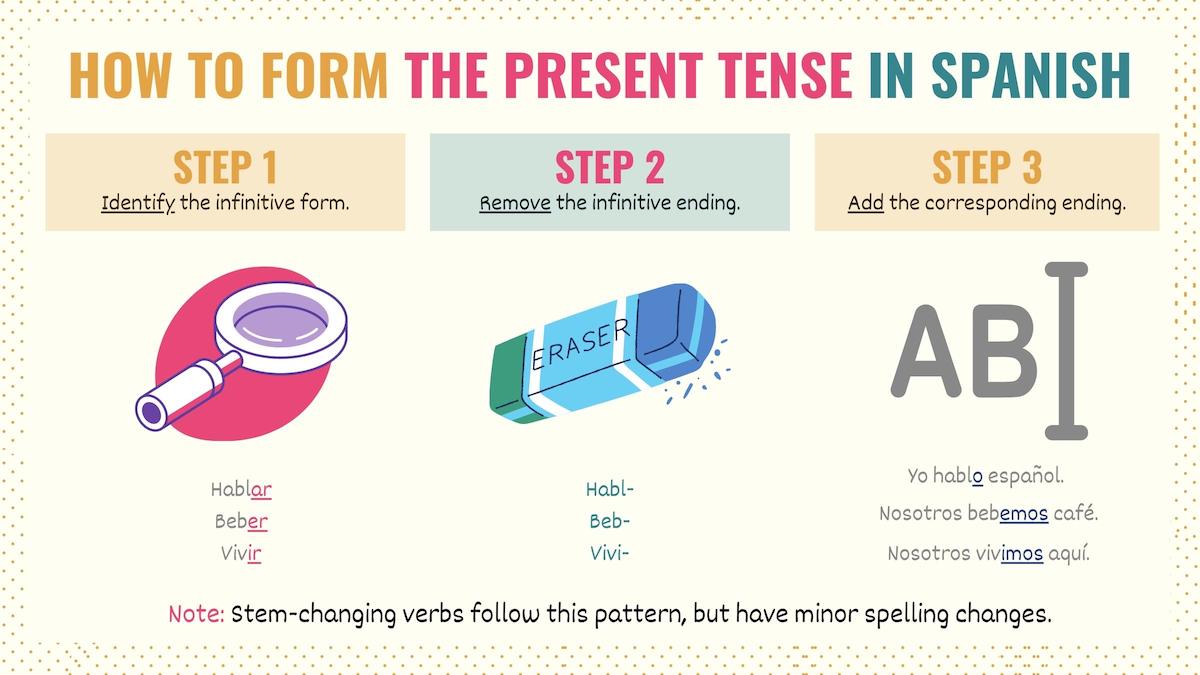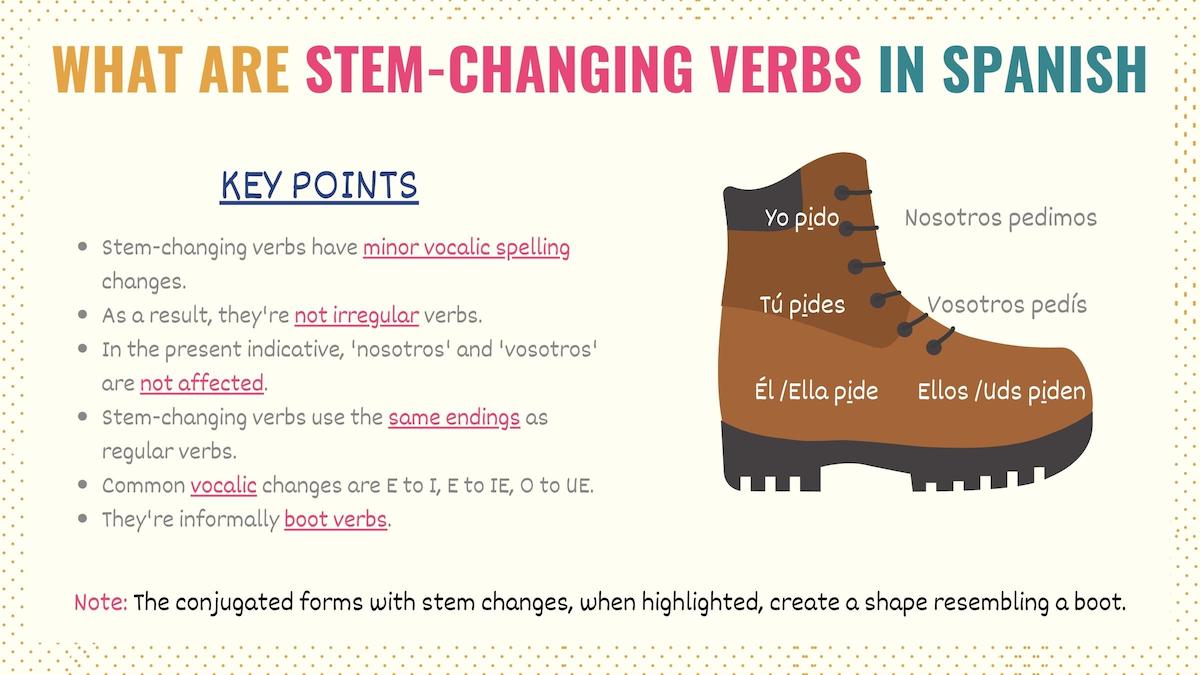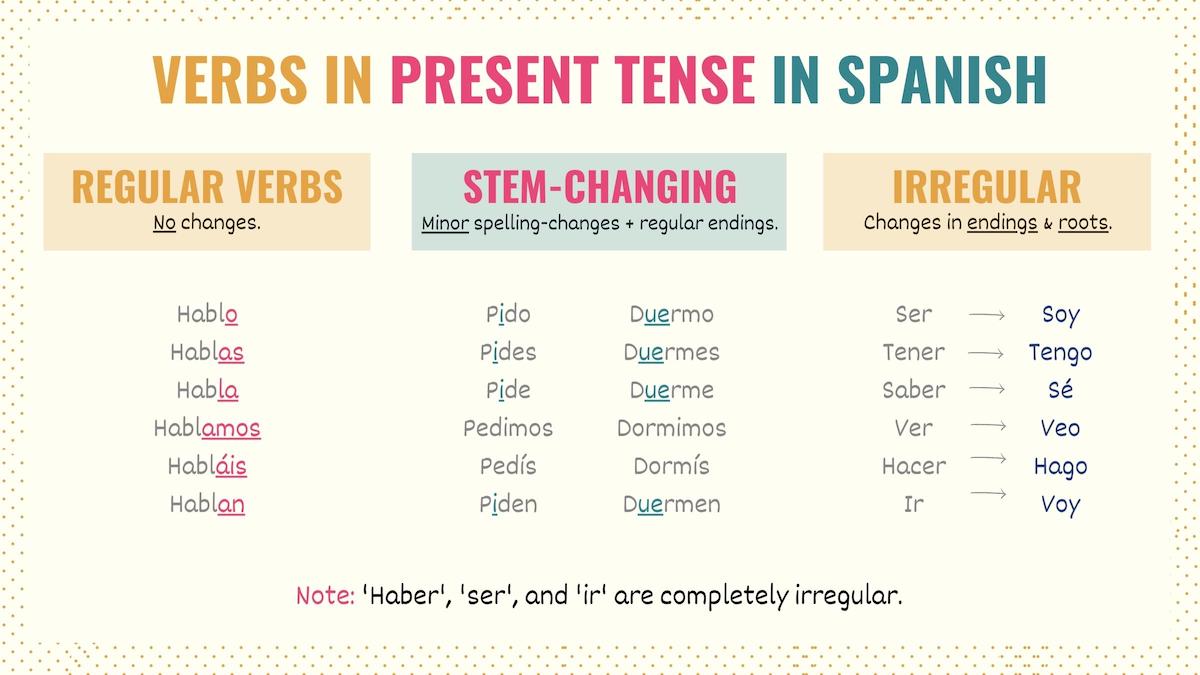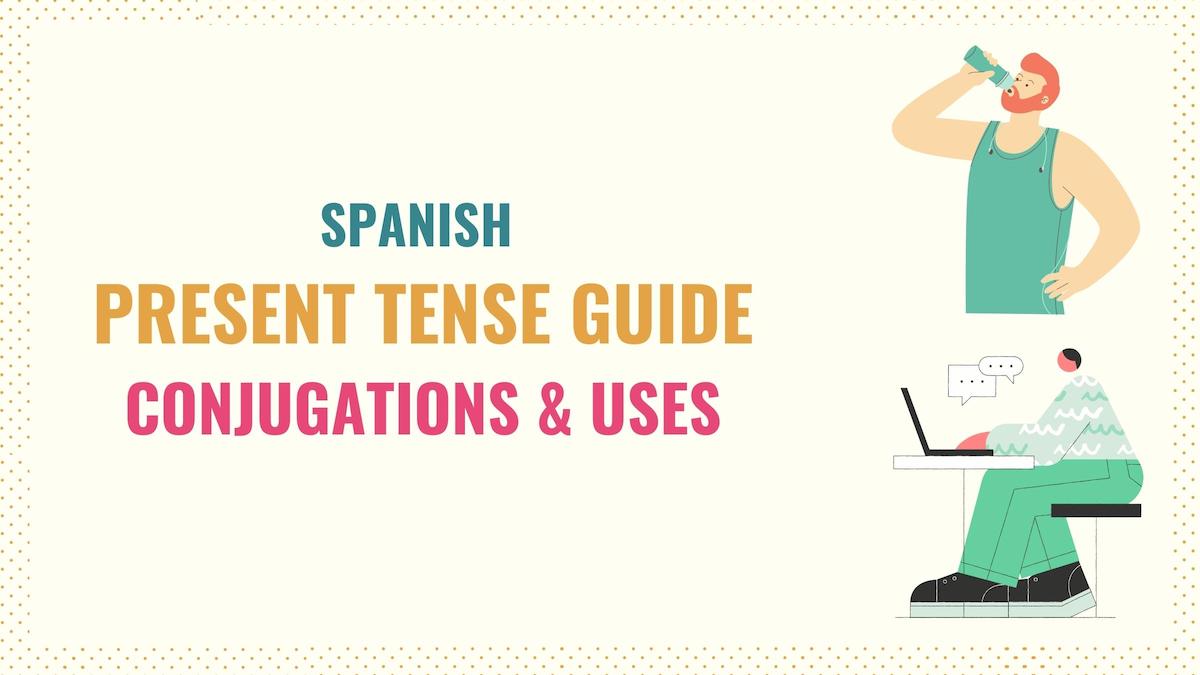The present indicative is one of the most basic Spanish tenses. Mastering this tense is not only fundamental for holding simple conversations, but it’s also essential for conjugating to more advanced tenses. Therefore, in this present tense Spanish guide, you’ll learn:
- How to Form the Present Tense
- When & How to Use the Present Indicative
- Key Points
- Next Steps & Resources
Present Tense Spanish Conjugation
The steps to conjugate a regular verb in the Spanish present tense are:
- Identify the verb’s infinitive form (ar, er, or ir).
- Drop the infinitive ending.
- Add the conjugation ending to the root.

The infinitive form of a verb defines the endings you must use when conjugating. For instance, the present endings in Spanish are:
Here are some conjugation tips for regular verbs in the present tense:
- The ending for yo is the same for all three conjugations.
- The conjugation for informal you (tú) ends in ‘s’.
- Except for ‘nosotros’ and ‘vosotros’, -ER and -IR verbs have the same endings.
- To remember the forms for ‘nosotros’, recite the vowel sounds ‘a’, ‘e’, ‘i’: –amos for ar verbs, –emos for er verbs, and –imos for ir verbs.
Take Note: As you can see in the conjugation chart above, in Spanish, each person has its own conjugation ending. Because these suffixes state who we’re talking about, Spanish subject pronouns are often omitted in a sentence.
Now that you know the rules for regular verbs in Spanish, let’s learn what to do with stem-changing and irregular verbs.
Stem-changing verbs
Many verbs in present form have minor spelling changes to maintain or ease the pronunciation or follow orthographic rules. These are known as Spanish stem-changing verbs.
Take the verb dormir as an example:
| Person | Conjugation |
|---|---|
| Yo | Duermo |
| Tú | Duermes |
| Él / Ella / Usted | Duerme |
| Nosotros | Dormimos |
| Vosotros | Dormís |
| Ustedes / Ellos / Ellas | Duermen |
Dormir (to sleep) has an O to UE stem. In other words, the letter o in the root (dorm) becomes ue (duerm) for all subject pronouns except ‘nosotros’ and ‘vosotros’.
Leaving these changes aside, you’ll use the endings for regular verbs.
Here are some examples of verbs with stem-changes in the present tense:
O to UE
- Contar: To count / To tell
- Dormir: To sleep
- Poder: Can / To be able to
- Probar: To taste / To try
- Volver: To come back
E to IE
- Cerrar: To close
- Despertar: To wake up
- Pensar: To think
- Querer: To want
- Tener*: To have
E to I
- Decir*: To say
- Pedir: To ask
- Vestir: To get dressed
CER to ZC (only for ‘yo’)
- Conocer: To meet
- Merecer: To deserve
- Parecer: To seem
*Note: As you’re about to see, tener and decir are irregular for the first-person singular (yo).
To learn more about this topic, check my guide on stem changing verbs.
Take Note: Spanish teachers call stem-changing verbs ‘boot verbs’ because the spelling changes don’t affect all the persons in the conjugation table. You can draw the shape of a boot around the subject pronouns that do have stem changes.

Irregular verbs in the present tense
In Spanish, irregular present tense verbs have significant changes in their root and, sometimes, their endings.
These are the irregular verbs in the present tense:
- Caer: To fall
- Dar: To give
- Decir: To say
- Estar: To be
- Hacer: To do
- Ir: To go
- Oír: To hear
- Poner: To put
- Saber: To know
- Salir: To leave
- Ser: To be
- Tener: To have
- Traer: To bring
- Venir: To come
- Ver: To see
Although their conjugations look random, these irregular verbs have some distinctive patterns that can make them easier to learn.
Let me show you what I mean.
Verbs with ‘go’ ending for ‘yo’
- Caer: Caigo, caes, cae, caemos, caéis, caen.
- Decir: Digo, dices, dice, decimos, decís, dicen.
- Hacer: Hago, haces, hace, hacemos, hacéis, hacen.
- Oír: Oigo, oyes, oye, oímos, oís, oyen.
- Poner: Pongo, pones, pone, ponemos, ponéis, ponen.
- Salir: Salgo, sales, sale, salimos, salís, salen.
- Tener: Tengo, tienes, tiene, tenemos, tenéis, tienen.
- Venir: Vengo, vienes, viene, venimos, vienen, vienen.
Aside from this, most of these verbs are regular in the other subject pronouns. Tener and decir are also stem-changing verbs. Finally, oír is a special case that requires you to replace the ‘i’ for a ‘y’ for the pronouns ‘tú’ and the third-person singular and plural.
Verbs with ‘oy’ ending for ‘yo’
- Dar: Doy, das, da, damos, dais, dan.
- Estar: Estoy, estás, está, estamos, estáis, están.
- Ir: Voy, vas, va, vamos, vais, van.
- Ser: Soy, eres, es, somos, sois, son.
From this list, ir and ser are irregular for all subject pronouns. The verb estar in the present tense has accented endings.
Verbs with unique patterns for ‘yo’:
- Haber: he, has, ha, hemos, habéis, han
- Saber: sé, sabes, sabe, sabemos, sabéis, saben.
- Ver: veo, ves, ve, vemos, veis, ven.
Take Note: By grouping irregular verbs like this, you only have to worry about memorizing a couple of forms.
When & How to Use the Spanish Present Tense
Like in English and other languages, the Spanish present tense is used to talk about activities that are happening in the present. This includes habitual actions and descriptions.
Check these present tense sentences:
Todos los días me levanto temprano.
I wake up early every morning.
Hanna no sabe cocinar muy bien.
Hanna doesn’t know how to cook very well.
Mis hermanos son abogados.
My parents are lawyers.
In addition to this basic application, the present indicative in Spanish is also used to:
Describe actions that will take place in the near future
In this context, it’s common to use time markers to express when the action takes place:
En un rato preparo la cena.
I am going to prepare dinner in a while.
Tenemos examen mañana.
We have an exam tomorrow.
The proper way to talk about actions occurring soon is to use the near future tense. Ir + a + infinitive is the structure used to form this tense.
Express the duration of an action
When combined with hace que, the present tense refers to an action that started in the past and continues in the present:
Hace + [amount of time] + que + [present tense]
Hace dos años que conozco a Luis.
I’ve known Luis for two years.
Hace mucho que no vemos una película.
We haven’t seen a movie in a long time.
Take Note: Unlike English, in Spanish, we don’t use an auxiliary verb (like do) to form questions or negative statements.
Key Points
The present Spanish tense is the foundation for learning more advanced tenses and communicating effectively. Here are some important points you should remember:
- Depending on their infinitive ending, the present tense has three sets of endings.
- To conjugate a verb, the infinitive ending must be replaced with the corresponding conjugation ending.
- Regular verbs and stem-changing verbs use the same endings.
- Stem-changing or boot verbs have minor spelling changes, which don’t affect ‘nosotros’ and ‘vosotros’.
- Spanish irregular verbs for the present tense undergo significant changes in their root or endings.
- The present tense of reflexive verbs follows the same conjugation rules as a non-reflexive verb. However, you must choose the reflexive pronoun that corresponds to the subject.

Additional Resources to Master the Present Tense
Here are some resources that can help you master the present indicative tense:
- How to Conjugate Verbs in Spanish: If the terms root, infinitive, and endings are still confusing or new to you, in this guide, you’ll discover how to conjugate verbs properly.
- Most Common Verbs in Spanish: As its name suggests, I’ve compiled a list of the essential verbs you should know in this resource. Additionally, I’ve included conjugation quizzes so you can practice the present tense conjugation.
- How to Conjugate Reflexive Verbs: Most new learners struggle with reflexive verbs. As a result, this guide specifically focuses on teaching how to conjugate these verbs.
- Guide to Present Progressive: The present progressive is a form of the present tense that communicates that an action is taking place at the moment of speaking. Check this guide to see how to form this tense and when to use it.
- Guide to Present Perfect: The present indicative is the first step to learn more advanced tenses. The present perfect is one of them. So, make sure you take the time to check this resource.
- Spanish Tenses: If you want to see the most important tenses in Spanish, click on the link to check them out.
As a beginner, you should also learn basic nouns and adjectives to make your sentences richer and more expressive. Once you’re ready, you can test your knowledge by taking this quiz.
Download PDF
The present indicative tense is the foundation for learning more complex tenses. So, I’ve compiled a PDF with its uses and conjugations. You can download it by clicking on the button below.



